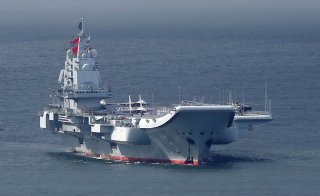How Dangerous Is China's Navy?
Let's find out.
Many of China’s ship classes—including the Type 054A, Type 056, and even the Type 052D—have been built so rapidly their construction runs are complete or could be completed within one to three years. Unless the PLAN is geared towards some massive effort to outmatch the U.S. Navy in the Pacific, surface ship construction should start winding down, leaving carriers, amphibious assault ships, and exports in the queue.
The breakneck pace of Chinese naval construction makes the People’s Liberation Army Navy a force to watch. The PLAN is not only in the process of modernizing but also expanding, with shipbuilding schedules not seen since the height of the Cold War. From carriers to corvettes, the Chinese Navy is expanding faster than any other navy on the planet. As a result, it’s often useful to check in and see the current state of the navy, and wonder what it’s all meant for.
(This first appeared last month.)
China’s aircraft carrier program marches on, with two carriers completed and a third ship under construction. In 2017 the first carrier Liaoning, as the Pentagon’s recently released 2018 China Military Power Report (PDF) noted, made two high profile voyages to Hainan Island and Hong Kong. That having been said, despite being in operation for more than three years it has yet to travel to a foreign country.
At the same time China’s second carrier, the unnamed Type 002 ship, is currently portside at Dalian and undergoing shore-based systems testing. Type 002 is very similar both dimensionally and in outer appearance to Liaoning, retaining conventional propulsion and a ski-jump for assisted takeoffs. The ship differs in having minor changes to the superstructure, including new advanced electronically scanned array (AESA) radars, and can carry twenty-four to thirty J-15 fighters—slightly more than Liaoning.
Meanwhile, China’s third carrier, the also-unnamed Type 003, is under construction at Shanghai’s Jiangnan Shipyard. Unlike the Type 002 ship the shipyard is building the 003 in modules (known as “superlifts” in American shipyards) to be assembled in drydock, just like the U.S. Navy’s supercarriers. Construction won’t be the only thing 003 shares with her American counterparts—the ship will reportedly be the first Chinese surface ship to rely on nuclear propulsion, and will use either steam or electromagnetic catapults to launch aircraft.
Full-sized aircraft carriers may not be the only aviation-capable ships in China’s near future. The long-awaited Type 075 class amphibious helicopter dock ships, similar to the U.S. Navy’s Wasp-class ships, are reportedly nearing construction. A following up to the Type 071 landing platform dock ships. The 075s would feature full-length flight decks, an island superstructure, and could embark both transport helicopters and the Type 726 “Yuyi” hovercraft. Like their American counterparts, the 075s could also accommodate fixed-wing vertical takeoff and landing aircraft, but there is no sign (yet!) of such an aircraft. Three 075s could be complete by 2025.
Meanwhile, in the world of surface combatants, the Pentagon has classified China’s new Type 055 ship as a larger cruiser rather than a smaller destroyer. The Type 055 class weighs at least 10,000 tons and may weigh as much as 13,000 tons, placing it comfortably in cruiser range.
Like their Ticonderoga-class counterparts, the Type 055s appear to be multipurpose ships with an emphasis on protecting China’s young carrier force from aerial attack.
The Type 055 cruisers each mount a single 130-millimeter deck gun, 112 vertical launch missile silos for air defense, land attack, anti-ship, and anti-submarine weapons, and two embarked helicopters. China launched two Type 055s simultaneously in July 2018 and six are currently under construction, as the PLAN is thought to have a requirement for at least eight of the cruisers.
Smaller combatants are also being constructed at a brisk clip. China recently launched its fiftieth Type 056/A corvette, Wuzhou. The Type 056 class ships are meant to replace smaller, older PLAN frigates and aging Type 037 corvettes with a sleek, modern multipurpose warship. The Type 056 is a general purpose ship capable of anti-submarine warfare, convoy escort, showing the flag, surveillance, and anti-air, anti-ship, and anti-submarine warfare. A variant, the Type 056A, features both a hull-mounted and towed, variable depth sonars and additional anti-submarine weapons.
Recommended: Imagine a U.S. Air Force That Never Built the B-52 Bomber
Recommended: Russia's Next Big Military Sale - To Mexico?
Recommended: Would China Really Invade Taiwan?
All the more astonishing is the fact that the Type 056 class has only been under construction since 2012, meaning Chinese shipyards have cranked this new generation of corvettes out at a rate of approximately one new ship every one and a half months—more if one counts the six export variants with less powerful weapons exported to Bangladesh and Nigeria. China may ultimately build as many as sixty-four of the corvettes.
Many of China’s ship classes—including the Type 054A, Type 056, and even the Type 052D—have been built so rapidly their construction runs are complete or could be completed within one to three years. Unless the PLAN is geared towards some massive effort to outmatch the U.S. Navy in the Pacific, surface ship construction should start winding down, leaving carriers, amphibious assault ships, and exports in the queue.
With all of this shipbuilding capacity (and shipbuilding jobs on the line) the obvious question is what the shipyards will build next. Submarine construction is one possibility, as well as smaller amphibious craft, particularly LSTs capable of carrying a dozen or so tanks and armored vehicles. China’s military opacity means outside observers just don’t know. Whatever the ultimate goal, China is already a major military power in the Asia-Pacific.
Kyle Mizokami is a writer based in San Francisco who has appeared in The Diplomat, Foreign Policy, War is Boring and The Daily Beast. In 2009 he co-founded the defense and security blog Japan Security Watch.


